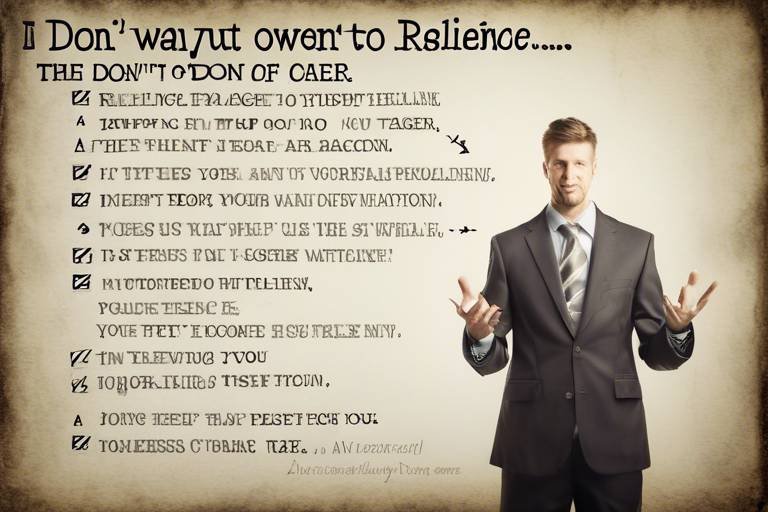Power of Resilience - A Guide to Overcome Career Stagnation
In today’s fast-paced world, feeling stuck in your career is more common than you might think. It's like being on a treadmill—you're putting in the effort, but you're not getting anywhere. This is where the power of resilience comes into play. Resilience is not just a buzzword; it’s a vital skill that can help you navigate through the murky waters of career stagnation. Imagine resilience as your personal life raft, helping you stay afloat when the waves of uncertainty crash around you. This article dives deep into understanding resilience, identifying the signs of stagnation, and providing you with actionable strategies to reignite your professional journey.
So, what exactly is resilience? It's the ability to bounce back from setbacks, adapt to change, and keep moving forward despite the odds. In the workplace, resilience is crucial because it enables individuals to handle stress, embrace challenges, and ultimately thrive in their careers. Think of it as your mental muscle; the more you work on it, the stronger it becomes. Cultivating resilience involves developing a positive mindset, maintaining a sense of purpose, and fostering strong relationships with colleagues. It’s about viewing challenges as opportunities for growth rather than insurmountable obstacles.
Recognizing the signs of career stagnation is the first step toward initiating change. You might find yourself feeling unmotivated, bored, or even trapped in your current role. Ask yourself: Are you excited about your work? Do you feel challenged? If the answer is no, you might be experiencing stagnation. Some common indicators include:
- Feeling disengaged or uninspired by your tasks.
- Lack of opportunities for advancement or skill development.
- Consistent feelings of frustration or dissatisfaction with your job.
Assessing your current professional situation can help you pinpoint the root causes of your stagnation, making it easier to develop a plan for moving forward.
Career stagnation can stem from various factors, including personal barriers, organizational challenges, and market-related issues. Understanding these causes is essential for overcoming them.
Internal obstacles like fear of failure and a lack of motivation can significantly impede your progress. These personal barriers often manifest as self-doubt or procrastination. To combat these feelings, it’s important to cultivate a growth mindset—viewing failures as learning experiences rather than definitive endpoints. Reflect on your past achievements to remind yourself of your capabilities. Perhaps keep a journal of your successes, no matter how small, to boost your confidence.
Workplace dynamics also play a significant role in career stagnation. A toxic company culture or ineffective management can stifle your growth and motivation. If you find yourself in an environment that doesn't support your ambitions, it might be time to reassess your situation. Open communication with your supervisors about your career goals can sometimes lead to unexpected opportunities for advancement. Remember, a positive work environment can be a game-changer in your professional journey.
Implementing effective strategies can enhance your resilience and help you cope with setbacks. Here are some actionable tips:
- Practice Mindfulness: Engage in mindfulness exercises to manage stress and maintain focus.
- Seek Support: Build a network of mentors and peers who can provide guidance and encouragement.
- Stay Adaptable: Embrace change and be willing to pivot your career path when necessary.
Establishing clear career goals is essential for overcoming stagnation. Without direction, it's easy to feel lost. By setting specific objectives, you create a roadmap for your professional journey. Think of goal-setting as planting seeds for your future—nurturing them will lead to growth and success.
The SMART framework offers a structured approach to goal-setting, ensuring your objectives are:
- Specific: Clearly define what you want to achieve.
- Measurable: Determine how you will track your progress.
- Achievable: Set realistic goals that challenge you but are attainable.
- Relevant: Ensure your goals align with your career aspirations.
- Time-bound: Establish deadlines to create a sense of urgency.
Continuous self-assessment is vital for tracking your progress. Regularly evaluating your skills and achievements can help you stay aligned with your career aspirations. Consider conducting a personal SWOT analysis (Strengths, Weaknesses, Opportunities, Threats) to identify areas for improvement and growth. This practice not only keeps you accountable but also empowers you to take charge of your career trajectory.
Q: How can I start building resilience?
A: Begin by embracing a growth mindset, practicing mindfulness, and seeking support from mentors and peers.
Q: What are some signs that I am experiencing career stagnation?
A: Common signs include feeling disengaged, lacking opportunities for advancement, and consistent frustration with your job.
Q: How do I set effective career goals?
A: Use the SMART framework to create clear, achievable, and time-bound goals that align with your aspirations.

Understanding Resilience
Resilience is often described as the ability to bounce back from setbacks, but it’s so much more than that. It’s about adaptability, growth, and the unwavering spirit to keep moving forward despite the challenges that life throws at us. In the workplace, resilience is a critical skill that can determine whether you thrive or merely survive. Think of it as your personal rubber band – it stretches and bends, but it always returns to its original shape, ready to take on new challenges.
In today’s fast-paced and ever-changing job market, cultivating resilience is essential. When faced with obstacles, resilient individuals don’t crumble; instead, they view challenges as opportunities for growth. They possess a unique ability to maintain a positive outlook, even when the going gets tough. So, how can you cultivate this powerful trait? Here are some key aspects to consider:
- Self-awareness: Understanding your emotions and reactions is the first step in building resilience. When you know what triggers your stress, you can develop coping strategies that work for you.
- Support systems: Surrounding yourself with a network of supportive colleagues, friends, and mentors can provide the encouragement you need during tough times.
- Problem-solving skills: Developing a proactive approach to tackling challenges can empower you to find solutions rather than dwell on the problems.
To truly harness the power of resilience, it’s important to recognize that it’s not an innate trait; it’s a skill that can be developed over time. Just like building muscle, the more you practice resilience, the stronger it becomes. Engaging in activities that challenge you, seeking feedback, and reflecting on your experiences can all contribute to strengthening your resilience.
Moreover, resilience is not just about individual fortitude; it also plays a significant role in fostering a positive workplace culture. Organizations that encourage resilience among their employees often see improved morale, higher productivity, and enhanced job satisfaction. When employees feel supported and equipped to handle stress, they’re more likely to contribute meaningfully to the organization’s goals.
In conclusion, understanding and cultivating resilience is essential for navigating the complexities of your career. It empowers you to face challenges head-on, adapt to changes, and ultimately thrive in your professional life. So, the next time you face a setback, remember that it’s not the end of the road but rather a stepping stone towards greater success.

Identifying Career Stagnation
Have you ever felt like you're stuck in a career rut, just going through the motions without any real progress? You're not alone. Identifying career stagnation is the first step towards reigniting your professional journey. This condition can be tricky to spot, especially when you’re caught up in the daily grind. But recognizing the signs is crucial for initiating change and moving forward.
So, what exactly does career stagnation look like? It can manifest in various ways, and it’s important to be aware of these indicators. For instance, if you find yourself feeling unchallenged at work, or if your daily tasks have become monotonous, it might be time to take a closer look at your situation. You might also notice a lack of enthusiasm for projects that once excited you, or perhaps you're not receiving any feedback or recognition for your efforts. These feelings can be subtle but are often the first whispers of stagnation.
Another significant sign is the absence of professional growth opportunities. If your company isn’t offering training, mentorship, or chances for advancement, it can lead to a sense of being trapped. Additionally, consider your emotional state: are you feeling more stressed or disengaged? Emotional fatigue can be a strong indicator that you’re not where you want to be in your career.
To help clarify your situation, here’s a quick checklist of questions you can ask yourself:
- Am I feeling unmotivated or uninspired at work?
- Have I received little to no feedback or recognition in recent months?
- Are my skills stagnating or becoming obsolete?
- Do I dread going to work more often than not?
- Have I stopped setting new career goals or aspirations?
If you answered 'yes' to several of these questions, it’s a clear signal that you might be experiencing career stagnation. But don’t worry; identifying the problem is the first step toward finding a solution. Once you recognize these symptoms, you can begin to explore ways to overcome them and reignite your passion for your career.
In addition to personal reflections, it’s also beneficial to assess external factors that could be contributing to your stagnation. This includes the overall health of your industry and the specific dynamics of your workplace. Are there opportunities for growth within your organization, or is the market shifting in a way that makes your current role less relevant? Understanding these elements can provide valuable context for your feelings and experiences.
Ultimately, recognizing career stagnation is about being honest with yourself and your current situation. It’s about taking a step back, evaluating where you are, and deciding where you want to go next. Remember, every career has its ups and downs, but with the right mindset and strategies, you can break free from stagnation and continue your journey toward success.
Q: What should I do if I identify that I am experiencing career stagnation?
A: The first step is to assess your current situation and identify specific areas where you feel stuck. From there, consider setting new goals, seeking mentorship, or exploring opportunities for professional development.
Q: Can career stagnation happen at any stage of my career?
A: Yes, career stagnation can occur at any point, whether you are just starting out or are a seasoned professional. It’s important to regularly evaluate your career path and make adjustments as needed.
Q: How can I prevent career stagnation in the future?
A: To prevent stagnation, focus on continuous learning, set clear career goals, and seek feedback regularly. Staying engaged and proactive in your career can help you remain dynamic and adaptable.

Common Causes of Stagnation
When it comes to career stagnation, it's essential to understand that it rarely happens overnight. Instead, it's often the result of a combination of factors that accumulate over time, creating a perfect storm that can leave you feeling stuck. So, what are some of the common causes of this frustrating phenomenon? Let's dive into the intricacies of personal, organizational, and market-related reasons that can hinder your professional growth.
First, let's talk about personal barriers. These are internal obstacles that can significantly impede your progress. For instance, fear of failure can act like a heavy anchor, keeping you from pursuing new opportunities. You might find yourself overthinking decisions or hesitating to take risks that could lead to career advancement. Additionally, a lack of motivation can sap your energy and enthusiasm, making it difficult to push forward. If you feel like you're just going through the motions at work, it’s time to take a step back and assess what's holding you back.
Next, we have organizational challenges. The environment in which you work plays a crucial role in your career trajectory. A toxic company culture can stifle creativity and innovation, leaving you feeling unappreciated and undervalued. If management styles are overly authoritarian or if there’s a lack of support for professional development, it can create a sense of stagnation. Employees thrive in environments that encourage growth, collaboration, and open communication. If your workplace lacks these elements, it may be time to evaluate your options.
Finally, let’s not forget about the market-related factors. Sometimes, external conditions can significantly impact your career path. Economic downturns can lead to job cuts and reduced opportunities for advancement. Additionally, rapid changes in technology and industry trends can leave you feeling out of touch if you don’t keep up. Staying relevant in your field is crucial; otherwise, you risk becoming obsolete, which can be a major contributor to stagnation.
In summary, understanding the common causes of career stagnation is the first step toward overcoming it. Whether it's personal fears, organizational challenges, or market dynamics, recognizing these factors allows you to address them head-on. Once you identify what's holding you back, you can take actionable steps to regain control of your career and move toward a more fulfilling professional life.
- What is career stagnation? Career stagnation refers to a period where an individual feels stuck in their professional growth, often characterized by a lack of advancement or new opportunities.
- How can I identify if I'm experiencing career stagnation? Signs include feeling unchallenged at work, lack of motivation, or a sense that your skills are not being utilized.
- What steps can I take to overcome career stagnation? Setting clear goals, seeking feedback, and continuously developing your skills are crucial steps to overcoming stagnation.

Personal Barriers
When we talk about career stagnation, one of the biggest culprits often lies within ourselves. Yes, those pesky can be like invisible chains holding us back from reaching our full potential. Think of it this way: just as a bird needs to spread its wings to soar, we too must break free from our self-imposed limitations. These barriers can manifest in various forms, but fear of failure and lack of motivation are two of the most common.
Fear of failure can feel like a dark cloud looming over our heads, casting shadows on our ambitions. It whispers doubts in our ears, convincing us that taking risks is not worth the potential pain of falling short. This fear can paralyze us, making us hesitant to pursue new opportunities or challenge ourselves. However, it's essential to recognize that failure is not the end—it's merely a stepping stone to success. Every setback carries lessons that can propel us forward, if only we allow ourselves to embrace them.
On the other hand, lack of motivation can be equally debilitating. Imagine trying to drive a car without fuel; it simply won’t go anywhere. Similarly, when we lack motivation, our career aspirations can stall. This can stem from various sources, such as burnout, dissatisfaction with our current roles, or even a disconnect between our values and our work. Understanding what drives us—our passions and interests—can reignite that spark. It’s crucial to take a step back and reflect on what truly excites us in our careers.
To overcome these personal barriers, we can implement several strategies:
- Self-Reflection: Spend time assessing your fears and motivations. Journaling can be a powerful tool to bring clarity to your thoughts.
- Set Small Goals: Break down your larger career aspirations into smaller, manageable tasks. Achieving these can build confidence and reduce the fear of failure.
- Seek Support: Surround yourself with a supportive network of friends, mentors, or colleagues who can encourage you to step outside your comfort zone.
By taking these proactive steps, we can dismantle the personal barriers that stand in our way. Remember, the journey to overcoming stagnation is not a sprint; it’s a marathon. It requires patience, perseverance, and a willingness to confront the internal struggles that may be holding us back. So, let’s embrace the challenges, learn from our experiences, and propel ourselves toward a more fulfilling career!
Q1: What are personal barriers?
Personal barriers are internal obstacles such as fear of failure or lack of motivation that can hinder career progress.
Q2: How can I identify my personal barriers?
Self-reflection and journaling can help pinpoint fears and motivations that may be affecting your career.
Q3: What steps can I take to overcome fear of failure?
Setting small goals, seeking support, and reframing your mindset about failure can help you overcome this fear.
Q4: How do I find motivation in my career?
Reassessing your passions, seeking new challenges, and surrounding yourself with positive influences can reignite your motivation.

Organizational Challenges
When it comes to career stagnation, can be some of the most significant hurdles to overcome. Imagine working in an environment where your potential feels stifled, like a bird trapped in a cage. Many professionals find themselves in such situations, where the company culture, management styles, and even the overall structure of the organization can hinder their growth. But what does this really mean? Let’s dive deeper into how these challenges manifest and what you can do about them.
First off, let’s talk about company culture. An organization's culture is the underlying ethos that shapes employee behavior and attitudes. If you’re in a workplace that promotes a lack of collaboration, innovation, or support, it can lead to feelings of isolation and stagnation. For instance, if your colleagues are more focused on competition than teamwork, it can create a toxic atmosphere that drains motivation and enthusiasm. In such environments, you might feel like your ideas are overlooked or that you’re not given the opportunities to shine. This can be incredibly frustrating, especially when you know you have the skills and capabilities to contribute meaningfully.
Moreover, the management style within an organization plays a crucial role in shaping your career trajectory. If you're dealing with a micromanaging boss, you might find it challenging to take initiative or feel empowered to make decisions. Alternatively, a lack of feedback or recognition from management can lead to a sense of being undervalued, which can, in turn, stifle your motivation to pursue new challenges. It’s like trying to grow a plant in the shade—it simply won’t thrive without the right conditions.
Additionally, organizational structures can also contribute to stagnation. Hierarchical structures can sometimes create barriers to communication and collaboration. If you feel like your voice isn’t being heard because of layers of bureaucracy, it can be disheartening. In these situations, employees often feel like they are just another cog in the machine, which can lead to a significant decline in job satisfaction.
Now, let’s explore some common organizational challenges that can contribute to career stagnation:
- Limited Growth Opportunities: When there are few avenues for advancement, it can be disheartening to stay in the same position for years.
- Lack of Training and Development: If your organization doesn’t invest in your professional growth, it can be tough to acquire new skills.
- Poor Communication: Ineffective communication can lead to misunderstandings and a lack of clarity in roles and expectations.
- Resistance to Change: Organizations that are resistant to change can stifle innovation and creativity, making it hard for employees to push boundaries.
So, what can you do if you find yourself facing these organizational challenges? First, it’s essential to assess your situation critically. Ask yourself whether the culture and management style align with your career goals. Open communication with your superiors about your aspirations can sometimes lead to unexpected opportunities. Additionally, seeking mentorship within or outside your organization can provide valuable insights and guidance. Remember, you have the power to advocate for yourself and seek out the growth you desire, even in a challenging environment.
Q: How can I identify if my organization is stifling my growth?
A: Look for signs such as lack of feedback, minimal opportunities for advancement, and a culture that discourages collaboration. If you feel consistently unmotivated or undervalued, it may be time to reassess your position.
Q: What steps can I take to improve my situation?
A: Consider having open discussions with your manager about your career goals. Additionally, seek out training opportunities, network within your organization, and find a mentor who can help guide you.
Q: Is it worth staying in a stagnant job for a long time?
A: It depends on your personal and professional goals. If you see potential for growth or the opportunity to develop new skills, it may be worth staying. However, if stagnation persists without any signs of change, you might want to explore other options.

Strategies for Building Resilience
Building resilience is like strengthening a muscle; the more you work at it, the more capable you become of handling life's challenges. Just as athletes train to enhance their physical capabilities, professionals can cultivate resilience through specific strategies. These strategies not only help you bounce back from setbacks but also empower you to thrive in your career. So, how can you start building this essential trait? Here are some effective approaches:
First and foremost, embracing a growth mindset is crucial. This means viewing challenges as opportunities for learning rather than insurmountable obstacles. When you encounter a setback, instead of thinking, “I can’t do this,” shift your perspective to, “What can I learn from this experience?” This simple change in mindset can significantly alter how you approach difficulties in your career.
Next, consider the importance of developing a strong support network. Surrounding yourself with positive influences can make a world of difference. Whether it’s friends, family, or colleagues, having people who encourage you can provide the emotional support needed during tough times. It’s like having a safety net; when you stumble, there are people ready to catch you and help you get back on your feet.
Another effective strategy is to practice mindfulness and stress management techniques. Engaging in mindfulness practices, such as meditation or deep-breathing exercises, can help you stay grounded during turbulent times. These techniques allow you to pause and reflect rather than react impulsively, giving you the clarity needed to make informed decisions about your career. Regular practice can transform your approach to stress, turning it from a debilitating force into a manageable aspect of your life.
Additionally, setting realistic expectations for yourself can prevent feelings of overwhelm. It’s important to recognize that setbacks are a natural part of any career journey. By setting achievable goals and celebrating small victories, you can maintain motivation and build confidence. For instance, if you aim to learn a new skill, break it down into smaller tasks. This way, each completed task becomes a stepping stone toward your larger objective.
Lastly, embracing adaptability is key to resilience. The ability to adjust your plans and expectations in response to changing circumstances can significantly enhance your professional growth. Think of your career as a river; sometimes, you need to navigate around rocks and bends. By being flexible and open to new opportunities, you can turn potential roadblocks into pathways for advancement.
In summary, building resilience is a multifaceted process that requires intention and practice. By embracing a growth mindset, fostering a supportive network, practicing mindfulness, setting realistic expectations, and being adaptable, you can cultivate the resilience needed to overcome career stagnation. Remember, resilience is not just about enduring challenges; it’s about thriving despite them.
- What is resilience? Resilience is the ability to recover quickly from difficulties and adapt to challenging situations.
- How can I identify if I am experiencing career stagnation? Look for signs such as lack of motivation, feeling unchallenged, or not having opportunities for growth.
- Can resilience be learned? Absolutely! Resilience can be developed through practice and by adopting certain strategies.
- What are some quick tips to boost resilience? Embrace a growth mindset, build a support network, practice mindfulness, and set realistic goals.

Setting Career Goals
Establishing clear career goals is like setting the coordinates for a treasure map; without them, you might wander aimlessly, missing out on the opportunities that could lead you to success. When you're stuck in a rut, it’s easy to feel overwhelmed or lost, but having defined goals gives you a sense of direction and purpose. Think of your career as a journey—one that requires a roadmap to navigate through the twists and turns of professional life. So, how do you create this roadmap? Let’s delve into the essentials of goal-setting.
First off, it’s important to understand that not all goals are created equal. They need to be SMART: Specific, Measurable, Achievable, Relevant, and Time-bound. This framework not only clarifies what you want to achieve but also helps you track your progress along the way. For example, instead of saying, "I want to be better at my job," a SMART goal would be, "I will complete a project management course by the end of this quarter to enhance my skills." This specific approach gives you a clear target to aim for.
To effectively set your career goals, consider the following steps:
- Self-Reflection: Take some time to think about what you truly want from your career. What are your passions? What skills do you want to develop? Reflecting on these questions can help you identify your long-term vision.
- Break It Down: Once you have your long-term goals in mind, break them down into smaller, manageable milestones. This makes the journey less daunting and allows you to celebrate small victories along the way.
- Stay Flexible: Life is unpredictable, and so is your career. Be prepared to adjust your goals as needed. Flexibility is key to maintaining motivation and resilience.
After establishing your goals, it’s crucial to document them. Writing down your objectives not only solidifies your commitment but also serves as a constant reminder of what you're working towards. You might consider creating a vision board or using digital tools to track your progress. Remember, visualizing your goals can be a powerful motivator!
Moreover, regular self-assessment is vital for staying aligned with your career aspirations. Set aside time each month to evaluate your progress. Ask yourself questions like: Am I on track to meet my goals? What challenges have I faced, and how can I overcome them? This reflective practice not only keeps you accountable but also allows you to recalibrate your strategies as needed.
In summary, setting career goals is a fundamental step in overcoming stagnation. By crafting SMART goals, engaging in self-reflection, and maintaining flexibility, you empower yourself to navigate your career path with confidence and clarity. Remember, every small step you take toward your goals is a step away from stagnation and towards growth.
Q: How often should I reassess my career goals?
A: It's a good idea to reassess your career goals at least every six months. This allows you to stay aligned with your aspirations and make necessary adjustments.
Q: Can I change my career goals?
A: Absolutely! It's normal to evolve and change your goals as you grow personally and professionally. Just ensure that any new goals align with your long-term vision.
Q: What if I don’t know what my career goals should be?
A: Start by reflecting on your interests, skills, and values. Consider seeking guidance from a mentor or career coach who can help you clarify your aspirations.

SMART Goals Framework
The is an incredibly effective tool for anyone looking to break free from career stagnation. It provides a clear structure for setting goals that are not just dreams but actionable steps toward your future. So, what does SMART stand for? Let’s break it down:
Specific: Your goals should be clear and specific, so you know exactly what you’re aiming for. Instead of saying, "I want to get better at my job," a specific goal would be, "I want to improve my project management skills by completing a certification course."
Measurable: To track your progress, you need to ensure your goals are measurable. This means defining criteria for success. For instance, you could measure your progress by the number of projects you manage successfully or the score you achieve in your certification exam.
Achievable: While it’s great to aim high, your goals should be attainable. Setting unrealistic goals can lead to frustration. Consider your current skills and resources. If you’re new to project management, aiming to lead a major project within a month might be too ambitious. Instead, set a goal to lead a smaller project first.
Relevant: Your goals should align with your long-term career aspirations. Ask yourself, "Does this goal help me get closer to my ultimate career objectives?" For example, if you aspire to be a team leader, improving your management skills is highly relevant.
Time-bound: Lastly, every goal should have a deadline. This creates a sense of urgency and helps you prioritize your tasks. Instead of saying, "I will improve my skills," specify, "I will complete my certification by the end of Q2." This not only sets a clear timeline but also keeps you accountable.
When you combine these elements, you create a roadmap that guides you through your career journey. Here’s a simple table to illustrate how you can convert a vague goal into a SMART goal:
| Vague Goal | SMART Goal |
|---|---|
| Get a promotion | Achieve a promotion to Senior Manager by completing two leadership training sessions and leading three successful projects by the end of the year. |
| Learn new skills | Enroll in an online data analysis course and complete it within six months to enhance my analytical skills for my current role. |
By applying the SMART framework, you transform your aspirations into tangible objectives. It’s like having a map on a road trip; without it, you might end up lost or stuck in traffic. So, take the time to craft your goals using this structure, and watch how it propels you toward your desired career path!
Q1: Why is the SMART framework important for career development?
A1: The SMART framework is crucial because it helps you set clear, actionable, and realistic goals, making it easier to measure your progress and stay motivated.
Q2: Can I modify the SMART criteria to fit my needs?
A2: Absolutely! While the SMART criteria are a great guideline, feel free to adjust them to better suit your personal circumstances and career objectives.
Q3: How often should I review my SMART goals?
A3: Regular reviews are essential! Consider assessing your goals every 3-6 months to ensure they remain relevant and achievable as your career progresses.

Regular Self-Assessment
Regular self-assessment is a powerful tool in your career arsenal. Think of it as a personal GPS, guiding you through the winding roads of your professional journey. Just like a car needs to be checked for performance, your career requires periodic evaluations to ensure you’re on the right track. But what exactly does self-assessment entail? It’s more than just asking yourself if you’re happy at work; it’s about diving deep into your skills, experiences, and aspirations. This ongoing process helps you identify your strengths and areas for improvement, allowing you to make informed decisions about your career path.
To effectively conduct a self-assessment, consider the following steps:
- Reflect on Your Achievements: Take stock of what you’ve accomplished so far. Have you completed any significant projects? Did you receive any awards or recognition? Celebrate these milestones as they are indicators of your potential.
- Identify Skill Gaps: Be honest with yourself. Are there skills you wish to develop further? Perhaps you need to enhance your technical abilities or improve your communication skills. Recognizing these gaps is the first step towards bridging them.
- Seek Feedback: Don’t shy away from asking colleagues or mentors for their perspectives. Sometimes, an outside viewpoint can provide clarity and highlight strengths you may overlook.
- Set Future Goals: Based on your reflections and feedback, outline what you want to achieve in the next few months or years. Setting clear, actionable goals will give you direction and motivation.
Another effective method for self-assessment is using a SWOT analysis. This technique helps you evaluate your Strengths, Weaknesses, Opportunities, and Threats. Here’s a quick overview of how to apply it:
| SWOT Element | Description |
|---|---|
| Strengths | What do you excel at? What unique skills do you bring to the table? |
| Weaknesses | What areas do you struggle with? Where can you improve? |
| Opportunities | What external factors can you leverage for growth? Are there upcoming projects or roles that align with your skills? |
| Threats | What challenges could hinder your progress? Are there market changes or organizational shifts that may impact your career? |
By regularly engaging in self-assessment, you not only stay aligned with your career aspirations but also cultivate a sense of resilience. It’s like sharpening a tool; the more you assess and refine your skills, the better equipped you are to tackle challenges. So, take the time to reflect, adjust, and move forward with confidence. Remember, your career is a journey, and self-assessment is your compass, ensuring you navigate towards success.
Q: How often should I conduct a self-assessment?
A: It’s beneficial to conduct a self-assessment at least once every six months. However, feel free to do it more frequently, especially after completing significant projects or experiencing changes in your role.
Q: What if I find it hard to identify my strengths?
A: Consider seeking feedback from trusted colleagues or mentors. They can provide insights into your strengths that you may not recognize yourself.
Q: Can self-assessment help me change careers?
A: Absolutely! Self-assessment can clarify your skills and interests, helping you identify new career paths that align with your strengths and passions.
Frequently Asked Questions
- What is resilience and why is it important in my career?
Resilience is the ability to bounce back from setbacks and challenges. In your career, it’s crucial because it helps you navigate obstacles, adapt to changes, and maintain motivation even during tough times. Think of resilience as your personal safety net, allowing you to recover quickly and keep moving forward.
- How can I identify if I am experiencing career stagnation?
Recognizing career stagnation involves looking for signs such as lack of growth opportunities, feeling unchallenged, or experiencing decreased job satisfaction. If you find yourself going through the motions without any excitement or ambition, it might be time to assess your situation and consider making changes.
- What are some common causes of career stagnation?
Career stagnation can stem from various factors, including personal barriers like fear of failure, organizational challenges such as poor management or company culture, and external market conditions that limit growth opportunities. Understanding these causes is the first step in overcoming them.
- How can I overcome personal barriers to advancement?
To overcome personal barriers, start by identifying your fears and motivations. Setting small, achievable goals can help build confidence. Engage in self-reflection and seek feedback from others to gain perspective on your strengths and areas for improvement.
- What strategies can I implement to build resilience?
Building resilience involves developing a positive mindset, practicing self-care, and seeking support from peers or mentors. Techniques such as mindfulness, journaling, and setting realistic goals can also enhance your ability to cope with challenges.
- How do I set effective career goals?
Effective career goals should be specific, measurable, achievable, relevant, and time-bound (SMART). Start by outlining what you want to achieve in your career, then break those goals down into smaller, actionable steps to make them more manageable.
- Why is regular self-assessment important for my career?
Regular self-assessment allows you to track your progress, identify skills you need to improve, and ensure that your career path aligns with your aspirations. It’s like having a personal GPS for your career, helping you stay on course and make necessary adjustments along the way.



















